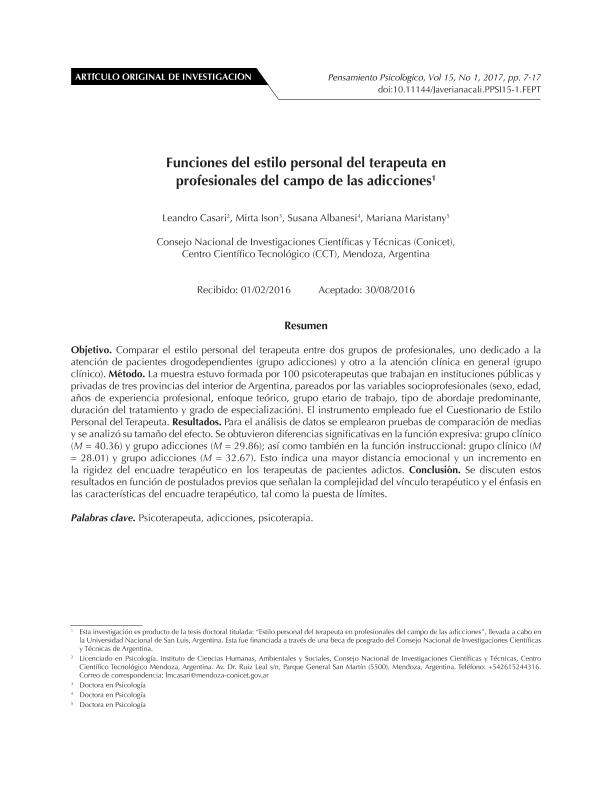Artículo
Comparar el estilo personal del terapeuta entre dos grupos de profesionales, uno dedicado a laatención de pacientes drogodependientes (grupo adicciones) y otro a la atención clínica en general (grupoclínico). Método. La muestra estuvo formada por 100 psicoterapeutas que trabajan en instituciones públicas yprivadas de tres provincias del interior de Argentina, pareados por las variables socioprofesionales (sexo, edad,años de experiencia profesional, enfoque teórico, grupo etario de trabajo, tipo de abordaje predominante,duración del tratamiento y grado de especialización). El instrumento empleado fue el Cuestionario de EstiloPersonal del Terapeuta. Resultados. Para el análisis de datos se emplearon pruebas de comparación de medias y se analizó su tamaño del efecto. Se obtuvieron diferencias significativas en la función expresiva: grupo clínico(M = 40.36) y grupo adicciones (M = 29.86); así como también en la función instruccional: grupo clínico (M= 28.01) y grupo adicciones (M = 32.67). Esto indica una mayor distancia emocional y un incremento en la rigidez del encuadre terapéutico en los terapeutas de pacientes adictos. Conclusión. Se discuten estos resultados en función de postulados previos que señalan la complejidad del vínculo terapéutico y el énfasis en las características del encuadre terapéutico, tal como la puesta de límites. The aim of this article was to compare the Personal Style of the Therapist (PST) between two groups of professionals: one specializing in the tending of drug addicted patients (Addiction Group), and the other specializing in general clinical practice (Clinical Group). Method. The sample was comprised of 100 psychotherapists who work in public and private institutions in three provinces from the interior of Argentina; an effort was made to standardize the demographic variables of both groups (similar proportion of gender, average age and years of experience, theoretical framework, treatment extension and skill of specialization). The Personal Style of the Therapist Questionnarie was used as an instrument of data collection, to assess the different functions of the PST. The subjects who belonged to the Addiction Group were contacted in specific institutions of treatment. Results. For the data analysis, means comparison tests were used and the effect size was calculated. Signifi cant differences were obtained in the Expressive Function: Clinical Group (M = 40.36) and Addiction Group (M = 29.86), similarly in the Instructional Function: Clinical Group (M = 28.01) and Addiction Group (M = 32.67). This would indicate a greater emotional distance and increased rigidity of the therapeutic setting in the addicted patients’ therapists. Conclusion. These results are discussed in terms of
previous assumptions that point out the complexity of the therapeutic relationship and the emphasis on the characteristics of the therapeutic setting, such as setting limits.
Funciones del estilo personal del terapeuta en profesionales del campo de las adicciones
Título:
Functions of the personal style of the therapist in specialists from the field of drug addiction
Fecha de publicación:
02/2017
Editorial:
Pontificia Universidad Javeriana Cali. Facultad de Humanidades y Ciencias Sociales
Revista:
Pensamiento Psicológico
ISSN:
1657-8961
Idioma:
Español
Tipo de recurso:
Artículo publicado
Clasificación temática:
Resumen
Archivos asociados
Licencia
Identificadores
Colecciones
Articulos(INCIHUSA)
Articulos de INST. DE CS. HUMANAS, SOC. Y AMBIENTALES
Articulos de INST. DE CS. HUMANAS, SOC. Y AMBIENTALES
Citación
Casari, Leandro Martín; Ison, Mirta Susana; Albanesi, Susana; Maristany, Mariana; Funciones del estilo personal del terapeuta en profesionales del campo de las adicciones; Pontificia Universidad Javeriana Cali. Facultad de Humanidades y Ciencias Sociales; Pensamiento Psicológico; 15; 1; 2-2017; 7-17
Compartir




